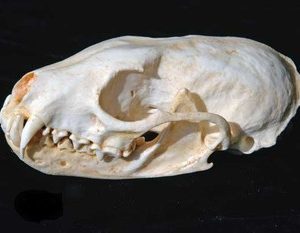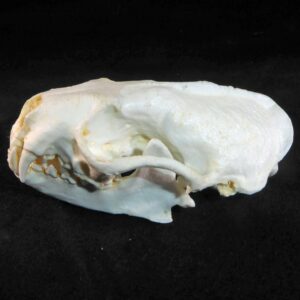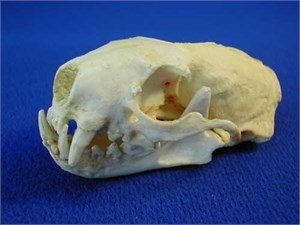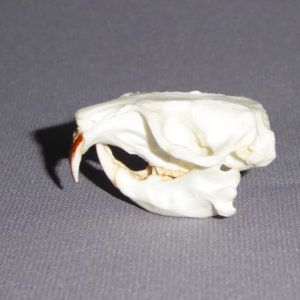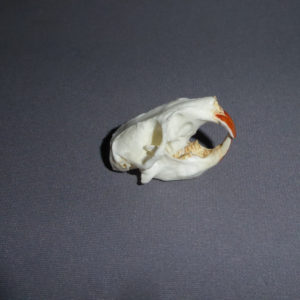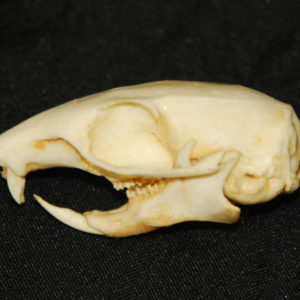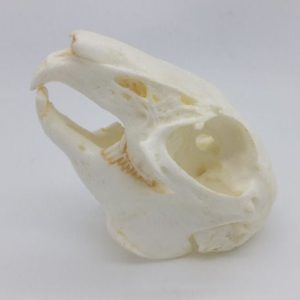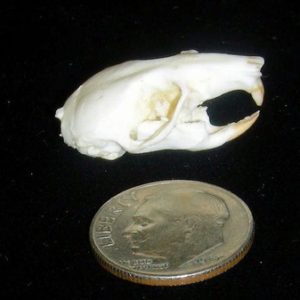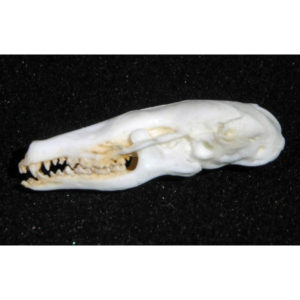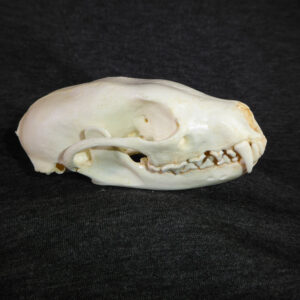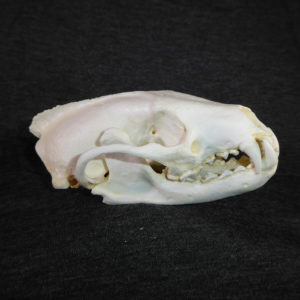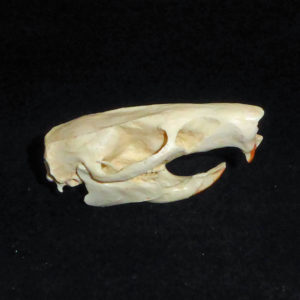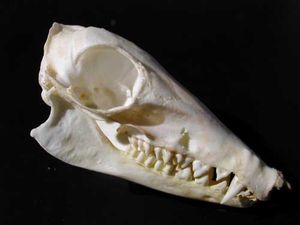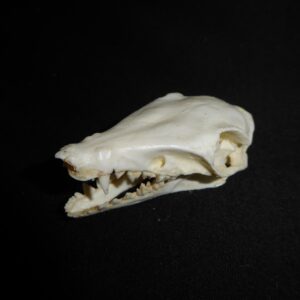All items sold on this website are polyurethane resin replicas, made in USA. No real or natural bone is available on this site.
Rodent Skull Replicas are museum quality polyurethane resin cast. Rodent Skull Replicas are made in USA.
Rodents are mammals of the order Rodentia, characterized by a single pair of continuously growing incisors in each of the upper and lower jaws that must be kept short by gnawing.
Rodents use their sharp incisors to gnaw wood, break into food, and bite predators. Most rodents eat seeds or plants, though some have more varied diets.
Rodents are extremely diverse in their ecology and lifestyles and can be found in almost every terrestrial habitat. All rodents share several morphological features, including having only a single upper and lower pair of ever-growing incisors.
Most rodents are small animals with robust bodies, short limbs, and long tails. They use their sharp incisors to gnaw food, excavate burrows, and defend themselves. Most eat seeds or other plant material, but some have more varied diets.
They tend to be social animals and many species live in societies with complex ways of communicating with each other.
-
African Striped Weasel Skull
$62.00The African Striped Weasel (Poecilogale albinucha), the lone member of the genus Poecilogale, is a small, black and white weasel native to sub-Saharan Africa.
-
Agouti Dasyprocto Skull Replica
$91.00The Agouti or Common Agouti is any of several rodent species of the genus Dasyprocta. They are native to Middle America, northern and central South America, and the southern Lesser…
-
American Marten Skull Replica
$91.00The American Marten (Martes americana), also known as the American Pine Marten, is a species of North American mammal, a member of the family Mustelidae. The species is sometimes referred…
-
American Mink Skull Replica
$61.00The American Mink (Neogale vison) is a semiaquatic species of mustelid native to North America, though human introduction has expanded its range to many parts of Europe, Asia, and South…
-
American Pika Skull Replica
$50.00Pikas are vocal, using both calls and songs to warn when predators are nearby and during the breeding season. Predators of the pika include eagles, hawks, coyotes, bobcats, foxes, and…
-
Asiatic Brush-Tailed Porcupine Skull
$121.00The Asiatic Brush-Tailed Porcupine is known to be one of the rarest porcupines in South Asia, the species is protected under Schedule II of the Indian Wildlife (Protection) Act, though…
-
Australian Water Rat Skull
$61.00The Rakali also known the Australian Otter or Water-rat, is an Australian native rodent first scientifically described in 1804. Adoption of the Aboriginal name Rakali is intended to foster a…
-
Black Footed Ferret Skull
$61.00It’s skull resembles that of polecats in its size, massiveness and the development of its ridges and depressions, though it is distinguished by the extreme degree of constriction behind the…
-
Black-Tailed Prairie Dog Skull
$61.00The Black-tailed Prairie Dog (Cynomys ludovicianus) is a rodent of the family Sciuridae (the squirrels) found in the Great Plains of North America from about the United States–Canada border to…
-
Common Pocket Gopher Skull
$62.00Most gophers have brown fur that often closely matches the color of the soil in which they live. Their most characteristic features are their large cheek pouches, from which the…
-
Crested Porcupine Skull Replica
$91.00The African Crested Porcupine is native to regions of Northern Africa, Southern Europe, and areas of the Mediterranean. This is a large species of porcupine, complete with a full compliment…
-
Eastern Chipmunk Skull Replica
$61.00The Eastern Chipmunk (Tamias striatus) is a chipmunk species found in eastern North America. It is the only living member of the chipmunk genus Tamias.
-
Eastern Cottontail Rabbit Skull
$61.00The Eastern Cottontail Rabbit (Sylvilagus floridanus) is a New World cottontail rabbit, a member of the family Leporidae. It is the most common rabbit species in North America. They can…
-
Eastern Deer Mouse Skull
$58.00Peromyscus maniculatus are found in all throughout eastern North America. The majority of deer mice nest high up, in large hollow trees. The deer mouse nests alone for the most…
-
Eastern Gray Squirrel Skull
$61.00The dental formula of the Eastern Gray Squirrel is 1023/1013 (upper teeth/lower teeth). 1.0.2.3, 1.0.1.3 × 2 = 22 total teeth. Incisors exhibit indeterminate growth, meaning they grow consistently throughout…
-
Eastern Mole Skull Replica
$52.00The Eastern Mole or Common Mole (Scalopus aquaticus) is a medium-sized North American mole. It is the only species in the genus Scalopus.
-
Eurasian Ermine Skull
$61.00Although Eurasian Ermine are primarily terrestrial, they climb trees and swim well. Tree roots, hollow logs, stone walls, and rodent burrows are used as dens.
-
Fisher Martes Female Skull
$91.00Skull and Dentition of male Fishers Martes generally are l 10-1 30 mm long, whereas those of females are 95-105 mm long. They have 38 teeth including four canine teeth.
-
Fisher Martes Male Skull
$75.00Skull and Dentition of male Fishers Martes generally are l 10-1 30 mm long, whereas those of females are 95-105 mm long. They have 38 teeth including four canine teeth.
-
Gambian Pouched Rat Skull
$90.00The Gambian pouched rat (Cricetomys gambianus), also commonly known as the African giant pouched rat, is a species of nocturnal pouched rat of the giant pouched rat genus Cricetomys, in…
-
Giant Pocket Gopher Skull
$50.00The Giant Pocket Gopher is the largest species of pocket gophers in the family Geomyidae. Like all other pocket gophers, the giant pocket gopher constructs extensive systems of tunnels under…
-
Golden-Rumped Elephant Shrew Skull
$91.00The Golden-rumped Elephant Shrew (Rhynchocyon chrysopygus) is a small African mammal. It is the largest species of the elephant shrew family along with its close relative the grey-faced sengi. It…
-
Greater Cane Rat Skull
$110.00As humans expanded into the cane rat’s native habitats, the cane rats likewise expanded from their native reeds into the plantations, particularly the sugar cane plantations from which they derive…




